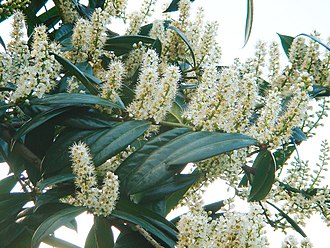
Native to southeastern Europe and the Middle East this evergreen shrub or small tree is a member of the rose family, Rosaceae, that also includes, apple, lady’s mantle, and pyracantha. The plant grows up to 20′ tall and has alternate leaves that are 6-10″ long, elliptical to oblong, and have 2-8 conspicuous glands on the blade underside near base and next to the midrib. In mid-spring, dense, axillary cylindrical racemes appear that are up to 4″ long and carry white, fuzzy, very sweet smelling flowers, attractive to butterflies and other pollinators. The berry-like fruits that follow are less than 1″ long and wide, purple-black, and attractive to birds. The shrub tolerates shade, spray and heavy pruning, and is useful as specimen, part of a foundation planting, or hedge. It is especially valued in the winter when its shiny dark green leaves keep the garden looking attractive. Plant with smoketree, barberries, Osmanthus and variegated euonymus for a pleasing contrast in color and texture. Cherry laural is a larval host plant to Eastern Tiger Swallowtail, and the leaves add an interesting texture to arrangements of greens especially at Christmas. The leaves and seeds are considered toxic to humans, pets and other animals when ingested. The genus name, Prunus, comes from the Greek word προύνη meaning plum, a prominent member of this genus. The specific epithet, lauroceraus, comes from the Latin words laurus, meaning laurel, and cerasus, meaning cherry.
Type: Evergreen flowering shrub.
Outstanding Feature: Dark green shiny leaves.
Form: Boxy.
Growth Rate: Rapid.
Bloom: Small white cup-shaped very fragrant flowers in upright 3-6” long racemes in mid spring.
Size: 10-20’ H x 6-8’ W
Light: Sun to partial shade.
Soil: Rich organic, moist but well drained soil but tolerates less; ph 4.5 to 7.5.
Fertilizer: Feed with an all purpose fertilizer in early spring and again in late summer.
Hardiness: Zones 6-9.
Care: Prune after flowering by cutting individual branches (shearing results in unsightly mutilated leaves).
Pests and Diseases: Susceptible to shot-hole disease, powdery mildew and root rot.
Propagation: Semi hardwood cuttings.
Outstanding Selection
‘Magnoliifolia’ (tall, large leaves resembling those of magnolias)
‘Majestic Jade’
‘Marbled Dragon’ (leaves with variegated blotches of white; small plant)
‘Otto Luyken’ (compact, 3-4′ H)
‘Schipkaensis’ (Goblet-shaped; 6.5′ H)
‘West Coast Schipkaensis’
‘Zabeliana’ (Willow-like leaves; cold tolerant)
Phot Credit: Karduelis Rize-Cayeli Wikimedia Commons
Any shrub that is evergreen and well behaved is welcome. Nice that the flowers are fragrant and it can be heavily pruned – useful for us with small gardens!
Have a good Christmas.
Yes, they are a great shrub and even do well in our heavy clay soil.